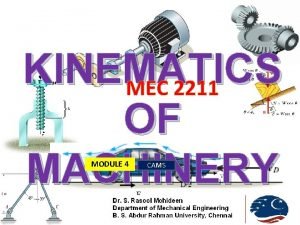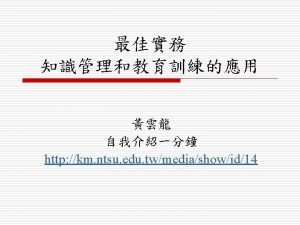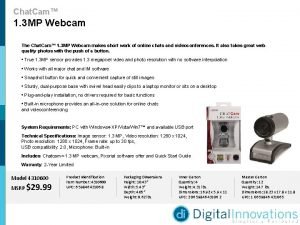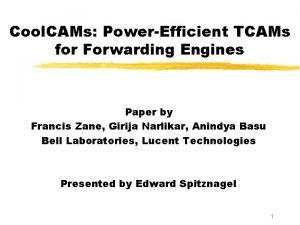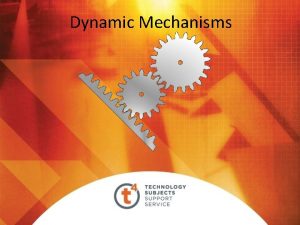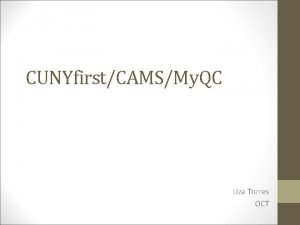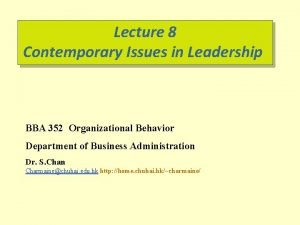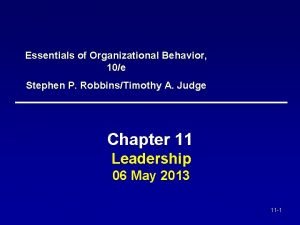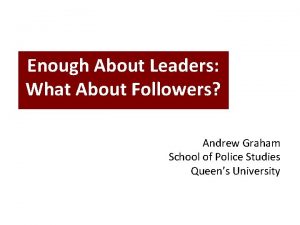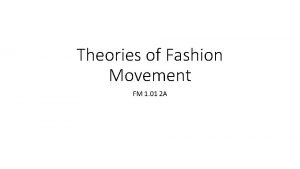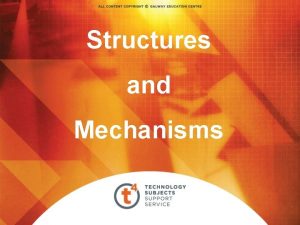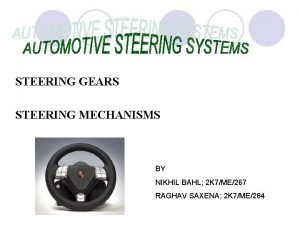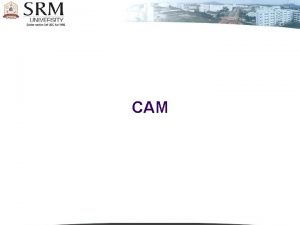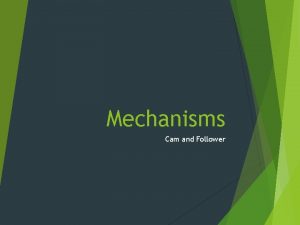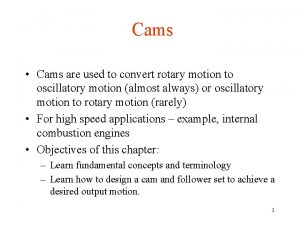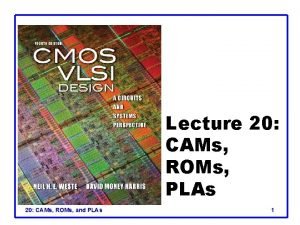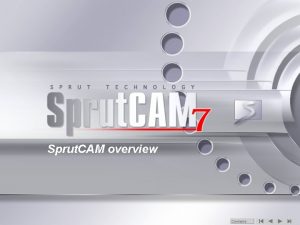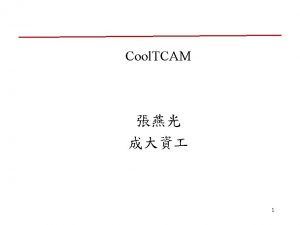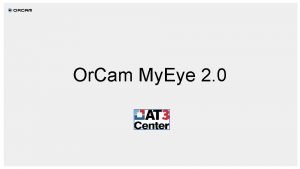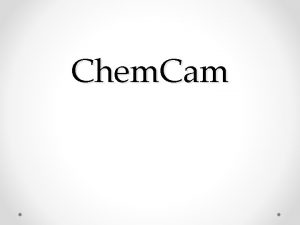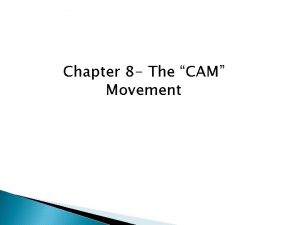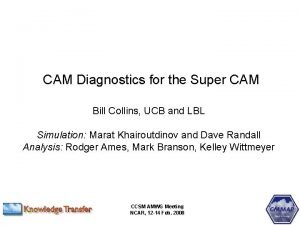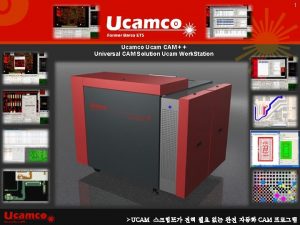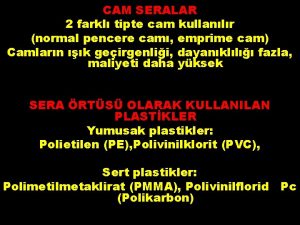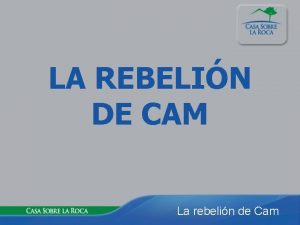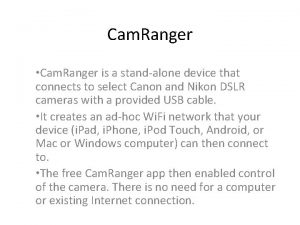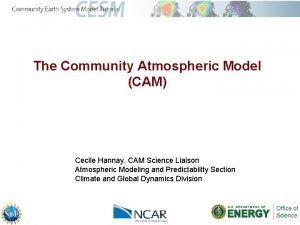INTRODUCTION TO CAMS AND FOLLOWERS Introduction A cam






























- Slides: 30

INTRODUCTION TO CAMS AND FOLLOWERS

Introduction • A cam is a mechanical member used to impart desired motion to a follower by direct contact. • The cam may be rotating or reciprocating whereas the follower may be rotating, reciprocating or oscillating. • Complicated output motions which are otherwise difficult to achieve can easily be produced with the help of cams. • Cams are widely used in automatic machines, internal combustion engines, machine tools, printing control mechanisms, and so on. • They are manufactured usually by die-casting, milling or by punch-presses. • A cam and the follower combination belong to the category of higher pairs. • Necessary elements of a cam mechanism are – – – A driver member known as the cam A driven member called the follower A frame which supports the cam and guides the follower

TYPES OF CAMS Cams are classified according to 1. shape, 2. follower movement 3. manner of constraint of the follower.

I. According to Shape 1) Wedge and Flat Cams A wedge cam has a wedge W which, in general, has a translational motion. The follower F can either translate [Fig. (a)] or oscillate [Fig. (b)]. A spring is, usually, used to maintain the contact between the cam and the follower. In Fig. (c), the cam is stationary and the follower constraint or guide G causes the relative motion of the cam and the follower.


2. Radial or Disc Cams • A cam in which the follower moves radially from the centre of rotation of the cam is known as a radial or a disc cam fig. (b). • Radial cams are very popular due to their simplicity and compactness.

3. Spiral Cams • A spiral cam is a face cam in which a groove is cut in the form of a spiral as shown in Fig. • The spiral groove consists of teeth which mesh with a pin gear follower. • The velocity of the follower is proportional to the radial distance of the groove from the axis of the cam. • The use of such a cam is limited as the cam has to reverse the direction to reset the position of the follower. It finds its use in computers.

4. Cylindrical Cams In a cylindrical cam, a cylinder which has a circumferential contour cut in the surface, rotates about its axis. The follower motion can be of two types as follows: In the first type, a groove is cut on the surface of the cam and a roller follower has a constrained (or positive) oscillating motion. Another type is an end cam in which the end of the cylinder is the working surface. A spring-loaded follower translates along or parallel to the axis of the rotating cylinder.

5. Conjugate Cams A conjugate cam is a double-disc cam, the two discs being keyed together and are in constant touch with the two rollers of a follower (shown in Fig. ). Thus, the follower has a positive constraint. Such a type of cam is preferred when the requirements are low wear, low noise, better control of the follower, high speed, high dynamic loads etc.

6. Globoidal Cams A globoidal cam can have two types of surfaces, convex or concave. A circumferential contour is cut on the surface of rotation of the cam to impart motion to the follower which has an oscillatory motion (Fig. ). The application of such cams is limited to moderate speeds and where the angle of oscillation of the follower is large.

7. Spherical Cams In a spherical cam, the follower oscillates about an axis perpendicular to the axis surface of rotation of the cam. Note that in a disc cam, the follower oscillates about an axis parallel to the axis of rotation of the cam. A spherical cam is in the form of a spherical surface which transmits motion to the follower (Fig. ).

II. According to Follower Movement 1. Rise-Return-Rise (R-R-R) In this, there is alternate rise and return of the follower with no periods of dwells (Fig. a). The follower has a linear or an angular displacement. 2. Dwell-Rise-Return-Dwell (D-R-R-D) In such a type of cam, there is rise and return of the follower after a dwell Fig. (b). this type is used more frequently than the R-R-R type of cam.

3. Dwell-Rise-Dwell-Return-Dwell (D-R-D) It is the most widely used type of cam. The dwelling of the cam is followed by rise and dwell and subsequently by return and dwell as shown in rig. (c). In case the return of the follower is by a fall [Fig. (d)], the motion may be known as Dwell-Rise-Dwell (D-R-D).

III. According to Manner of Constraint of the Follower • To reproduce exactly the motion transmitted by the cam to the follower, it is necessary that the two remain in touch at all speeds and at all times. • The cams can be classified according to the manner in which this is achieved. 1. Pre-loaded Spring Cam A pre-loaded compression spring is used for the purpose of keeping the contact between the cam and the follower. 2. Positive-drive Cam In this type, constant touch between the cam and the follower is maintained by a roller follower operating in the groove of a cam. The follower cannot go out of this groove under the normal working operations. A constrained or positive drive is also obtained by the use of a conjugate cam 3. Gravity Cam If the rise of the cam is achieved by the rising surface of the cam and the return by the force of gravity or due to the weight of the cam, the cam is known as a gravity cam. However, these cams are not preferred due to their uncertain behavior.

Classification of Followers 1. According to the surface in contact. a) Knife edge follower. When the contacting end of the follower has a sharp knife edge, it is called a knife edge follower, as shown in Fig. • The sliding motion takes place between the contacting surfaces (i. e. the knife edge and the cam surface). • It is seldom used in practice because the small area contacting of surface results in excessive wear.

(b) Roller follower. When the contacting end of the follower is a roller, it is called a roller follower, as shown in Fig. Since the rolling motion takes place between the contacting surfaces (i. e. the roller and the cam), therefore the rate of wear is greatly reduced. In roller followers also the side thrust exists between the follower and the guide. The roller followers are extensively used where more space is available such as in stationary gas and oil engines and aircraft engines.

(c) Flat faced or mushroom follower. When the contacting end of the follower is a perfectly flat face, it is called a flat-faced follower, as shown in Fig. It may be noted that the side thrust between the follower and the guide is much reduced in case of flat faced followers. The only side thrust is due to friction between the contact surfaces of the follower and the cam. • The flat faced followers are generally used where space is limited such as in cams which operate the valves of automobile engines. • When the flat faced follower is circular, it is then called a mushroom follower.

(d) Spherical faced follower. When the contacting end of the follower is of spherical shape, it is called a spherical faced follower, as shown in Fig. (d). It may be noted that when a flat-faced follower is used in automobile engines, high surface stresses are produced. In order to reduce these stresses, the flat end of the follower is machined to a spherical shape.

2. According to the motion of the follower (a) Reciprocating or translating follower. When the follower reciprocates in guides as the cam rotates uniformly, it is known as reciprocating or translating follower. The followers as shown in Fig. (a) to (c) are all reciprocating or translating followers.

(b) Oscillating or rotating follower. When the uniform rotary motion of the cam is converted into predetermined oscillatory motion of the follower, it is called oscillating or rotating follower. The follower, as shown in (e), is an oscillating or rotating follower.

3. According to the path of motion of the follower. (a) Radial follower. When the motion of the follower is along an axis passing through the center of the cam, it is known as radial follower. (b) Off-set follower. When the motion of the follower is along an axis away from the axis of the cam center, it is called off-set follower

CAM Nomenclature • Pitch curve : The path generated by the trace point as the follower is rotated about a stationery cam. Prime circle: The smallest circle from the cam center through the pitch curve • Base circle: It is the smallest circle that can be drawn to the cam profile.

CAM Nomenclature • Pressure angle: The angle between the direction of the follower movement and the normal to the pitch curve. • Pitch point: Pitch point corresponds to the point of maximum pressure angle. • Trace point. It is a reference point on the follower and is used to generate the pitch curve. In case of knife edge follower, the knife edge represents the trace point and the pitch curve corresponds to the cam profile. In a roller follower, the center of the roller represents the trace point.

CAM Nomenclature • Pitch circle: A circle drawn from the cam center and passes through the pitch point is called Pitch circle • Stroke: The greatest distance or angle through which the follower moves or rotates

Motion of the Follower The follower, during its travel, may have one of the following motions. Uniform velocity Simple harmonic motion Uniform acceleration and retardation Cycloidal motion

Displacement, Velocity and Acceleration Diagrams when the Follower Moves with Uniform Velocity The displacement, velocity and acceleration diagrams when a knifeedged follower moves with uniform velocity are shown in Fig. (a), (b) and (c) respectively. The abscissa (base) represents the time (i. e. the number of seconds required for the cam to complete one revolution) or it may represent the angular displacement of the cam in degrees. The ordinate represents the displacement, or velocity or acceleration of the follower.




THANK YOU
 Displacement diagram of cam and follower
Displacement diagram of cam and follower Cam.cam.cc
Cam.cam.cc External estop requested
External estop requested Cam 2cam chat
Cam 2cam chat Graduation gremlins
Graduation gremlins Funky-cams
Funky-cams Cams a
Cams a Cams suicide assessment
Cams suicide assessment Dirty router cam
Dirty router cam How to use hello sign
How to use hello sign Where can i find my emplid cuny
Where can i find my emplid cuny Why do prince prospero and his followers retreat
Why do prince prospero and his followers retreat What is house path goal theory
What is house path goal theory How do charismatic leaders influence followers
How do charismatic leaders influence followers How do charismatic leaders influence followers
How do charismatic leaders influence followers Alienated followers
Alienated followers How do charismatic leaders influence followers
How do charismatic leaders influence followers Be ye therefore followers of god
Be ye therefore followers of god Kellerman's typology of followers
Kellerman's typology of followers Buddhism number of followers
Buddhism number of followers What ideas of jesus attracted followers
What ideas of jesus attracted followers Fashion followers example
Fashion followers example Followers of islam
Followers of islam A good leader will have followers who ______.
A good leader will have followers who ______. Military industrial complex
Military industrial complex The world's largest universalizing religion is
The world's largest universalizing religion is Heart cam mechanism
Heart cam mechanism Universal joint vex
Universal joint vex Cam and follower vex
Cam and follower vex Leadscrew vex
Leadscrew vex Cam and peg steering gear
Cam and peg steering gear
